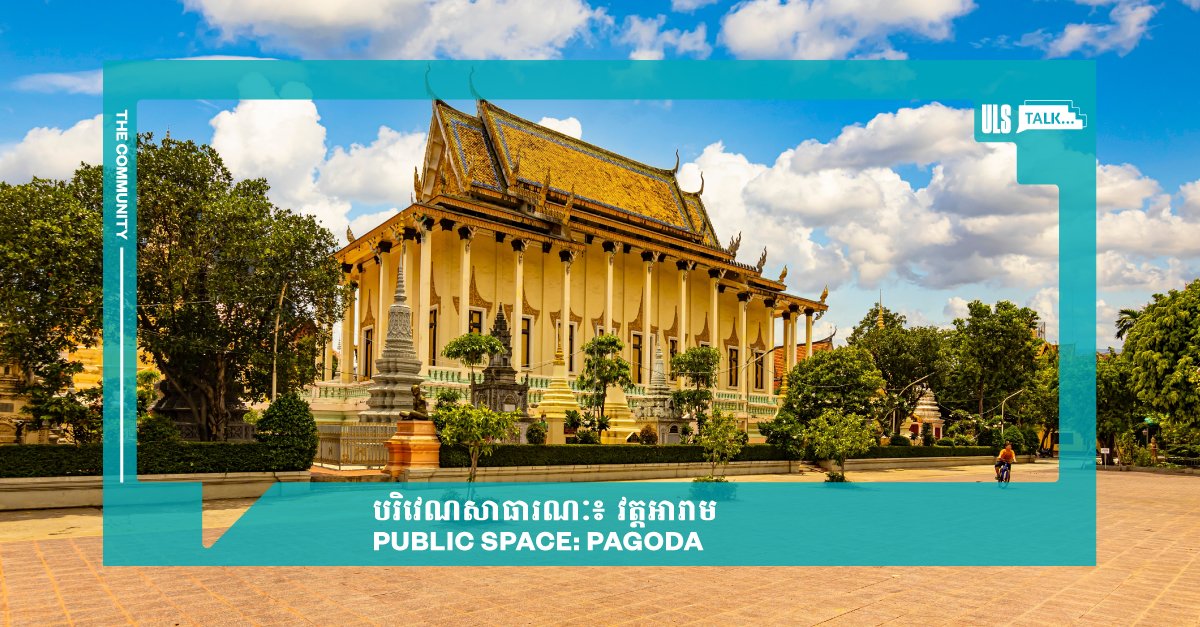បរិវេណសាធារណៈ ៖ វត្តអារាម / Publich Space : Pagoda
[English below]
ប្រទេសកម្ពុជា ជាប្រទេសដែលសម្បូរទៅដោយ វប្បធម៌ និងប្រវត្តិសាស្ត្រ។ បើយោងតាមរបាយការណ៍របស់ក្រសួងធម្មការ និងសាសនា បានបញ្ជាក់ថា ប្រជាជនកម្ពុជា 93% ជាអ្នកកាន់សាសនាព្រះពុទ្ធ ព្រមទាំងមានវត្តអារាមចំនួន 4872 នៅទូទាំងប្រទេស។ វត្តអារាមទាំងនេះច្រើនតែបម្រើក្នុងគោលបំណងលើសពីកន្លែងសម្រាប់គោរពប្រតិបត្តិសាសនា។ តើវត្តអារាមមានគោលបំណងបន្ថែមអ្វីផ្សេងទៀត ហើយហេតុអ្វីបានជាយើងគ្រប់គ្នាគួរតែយកចិត្តទុកដាក់ទៅលើចំណុចទាំងនោះ?
មនុស្សគ្រប់គ្នា អាចចូលទៅក្នុងវត្តអារាមដោយសេរី និងមិនមានតម្រូវឲ្យបង់ថវិកាឡើយ។ គ្រប់ពេលដែលពុទ្ធសាសនិកជនគ្រប់រូបអញ្ជើញទៅកាន់ទីវត្តអារាម ពួកគេនឹងត្រូវជួបដោយក្លិនក្រអូបផ្កាភ្ញី ក៏ដូចជាផ្សែងធូបទៀនជាដើម។ លើសពីនេះទៀត សំឡេងជជែកគ្នាលេង និងសើចសប្បាយរបស់ពុទ្ធសាសនិកជនក៏មានបន្លឺអឺងកងផងដែរ។ ទោះជាលោកអ្នកមិនស្គាល់នរណាម្នាក់ក៏ដោយ នៅចុងបញ្ចប់នៃពិធីនីមួយៗ លោកអ្នកនឹងក្លាយជាផ្នែកមួយនៃការសន្ទនាដ៏រីករាយជាមួយពុទ្ធសាសនិកជនដទៃផ្សេងទៀត។ ប្រសិនបើយើងក្រឡេកមើលការរៀបចំរចនានៅក្នុងវត្តវិញ គឺត្រូវបានតុបតែងដោយគំនូរជញ្ជាំងចម្រុះពណ៌ដ៏រស់រវើក ដោយមានផ្ទាំងគំនូរខ្លះបង្ហាញពីរូបភាពគួរឲ្យខ្លាចជាមួយនឹងន័យដាស់តឿន ដូចជាគំនូរពណ៌នាអំពីការធ្វើទារុណកម្មនៅក្នុងឋាននរកទៅលើបុគ្គលដែលប្រព្រឹត្តអំពើបាប។ ស្នាដៃសិល្បៈផ្ទាំងគំនូរដ៏ប្រណិតទាំងនេះ ក៏មានការបង្ហាញអំពីរឿងរ៉ាវប្រវត្តិសាស្ត្រ ជំនឿ និងទំនៀមទម្លាប់ប្រពៃណីខ្មែរជាច្រើនផងដែរ។ ជាក់ស្ដែង ដូចជាដំណើរត្រាស់ដឹងរបស់ព្រះពុទ្ធអង្គ ដែលពិពណ៌នាអំពីដំណើរជីវិតរបស់ព្រះពុទ្ធមុន និងក្រោយពេលទ្រង់ត្រាស់ដឹង។
ថ្វីត្បិតតែវត្តអារាមត្រូវបានទទួលស្គាល់ថាជាទីកន្លែងពោរពេញទៅដោយភាពស្ងប់ស្ងាត់ ប៉ុន្តែបរិយាកាសនេះ ជារឿយៗ ត្រូវបានផ្លាស់ប្តូរក្នុងអំឡុងពេលពិធីបុណ្យធំៗ ដូចជាពីធីបុណ្យភ្ជុំបិណ្ឌ ឬពិធីបុណ្យចូលឆ្នាំខ្មែរជាដើម។ ក្នុងអំឡុងថ្ងៃ បុណ្យជាតិទាំងនេះ សមាជិកនៃសហគមន៍ជួបជុំគ្នាដើម្បីតុបតែងទីធ្លា និងរៀបចំបរិវេណវត្ត ដើម្បីបង្កើតបរិយាកាសស្វាគមន៍ និងកក់ក្ដៅសម្រាប់សហគមន៍ទាំងមូលឲ្យមានភាពរីករាយជាមួយនឹងពេលវេលាដ៏គួរឲ្យចងចាំនៃការប្រារព្ធកម្មពិធីរបស់ពួកគេ។ ការសហការរួមគ្នារវាងសមាជិកនៃសហគមន៍នេះ ជំរុញឱ្យមនុស្សមកជួបជុំគ្នា និងបណ្តុះនូវស្មារតីសាមគ្គីភាព បង្កើតជាទំនាក់ទំនងដ៏រឹងមាំដែលមិនអាចបំភ្លេចបានរវាងមិត្តភក្តិ ក្រុមគ្រួសារ និងអ្នកជិតខាងក្នុងតំបន់នោះ។ ក្រៅពីការប្រារព្ធពិធីបុណ្យសាសនានានា សាធារណជនក៏ប្រើប្រាស់វត្តអារាមក្នុងសកម្មភាពប្រចាំថ្ងៃផ្សេងទៀតផងដែរ ដោយអ្នកខ្លះប្រើជាទីកន្លែងសម្រាប់ជួបជុំមិត្តភក្ដិ និងក្រុមគ្រួសារ រីឯអ្នកខ្លះទៀត ប្រើវត្តអារាមដើម្បីស្វែងរកសេចក្ដីសុខក្នុងចិត្តតាមរយៈការធ្វើសមាធិ ការអាន ស្តាប់ការសូត្រធម៌ ឬបន់ស្រន់ជាដើម។
តាមរយៈការសិក្សាមួយរបស់ UNICEF នាពេលថ្មីៗនេះ បានរកឃើញថា វត្តអារាមកំពុងដើរតួនាទីយ៉ាងសកម្មលើសពីមុខងាររបស់ខ្លួន។ ក្រៅពីជាទីកន្លែងសក្ការបូជា វត្តអារាម បានផ្តល់ទីជម្រក និងការអប់រំដល់កុមារដែលជួបការលំបាក ជាពិសេសវត្តធំៗមួយចំនួន ត្រូវបានប្រើប្រាស់ជាមធ្យោបាយផ្ដល់ការអប់រំ “ជំនួស” គ្រឹះស្ថានអប់រំ។
មុខងាររបស់វត្តអារាម ត្រូវបានប្រែប្រួលដើម្បីសម្របទៅនឹងការផ្លាស់ប្តូរនៃបទដ្ឋាននៅក្នុងសង្គម និងរបៀបរស់នៅរបស់មនុស្ស។ វត្តអារាមអាចជាទីកន្លែងដ៏ពិសិដ្ឋ ប៉ុន្តែក៏ជាកន្លែងសម្រាប់បុគ្គលគ្រប់រូបអាចស្វែងរកនូវអារម្មណ៍នៃការផ្សារភ្ជាប់ទំនាក់ទំនងដ៏ជ្រាលជ្រៅជាមួយខ្លួនឯង និងសហគមន៍របស់ពួកគេផងដែរ។
[English version]
Cambodia is a country rich in culture and history. The Ministry of Cult and Religion reports that 93% of the population is Buddhist, and the country is home to 4,872 pagodas. Many of these serve as more than just a religious shrine. What are pagoda purposes beyond the religious aspects, and why should we pay attention to them?
Access to pagodas requires no entry fee. Visitors entering the pagoda are first struck by the smell of fresh flowers, incense, and smoke. In the background, you can hear the chit-chatting of visitors. Even if you do not know anyone, at the end of a ceremony, you will often find yourself in light conversation with other guests. The setting of pagodas is decorated with colorful but sometimes uncomfortable murals like the drawing that shows the graphic torture in hell of people who committed sinful acts. They tell tales of Khmer history, beliefs, and traditions. For instance, the tales of The Enlightenment of the Buddha visually describe the journey of Buddha before and after he becomes enlightened.
As peace and quiet appear to be characteristics of pagodas, the same cannot be said during big celebrations like Pchum Ben or Khmer New Year. During these holidays, members of the community come together to help decorate and arrange spaces in the vicinity. The goal is to create a welcoming space for the community to enjoy their time celebrating. This collaboration among community members brings people together and captures the spirit of unity that is rooted deeply within the shared goal of commemorating a memorable experience in the company of friends and family. Aside from the celebration, the public uses pagodas in daily life. Some visit as a place to meet and catch up with their loved ones, while others use it to find their peace of mind through meditation, reading, listening to chanting, or praying.
In a recent case study, UNICEF also found that pagodas are taking an active role beyond their respective functions. In addition to being a place of worship, pagodas also provide shelter and education for disadvantaged children, especially some of the larger pagodas, which are used as “alternative” means for education providers.
The usage of pagodas has progressed from its original purpose—they have adapted to the changes in society and the lifestyle of the people. Pagodas may be a sacred place, but they are also where people find their truest connection with themselves and their community.


